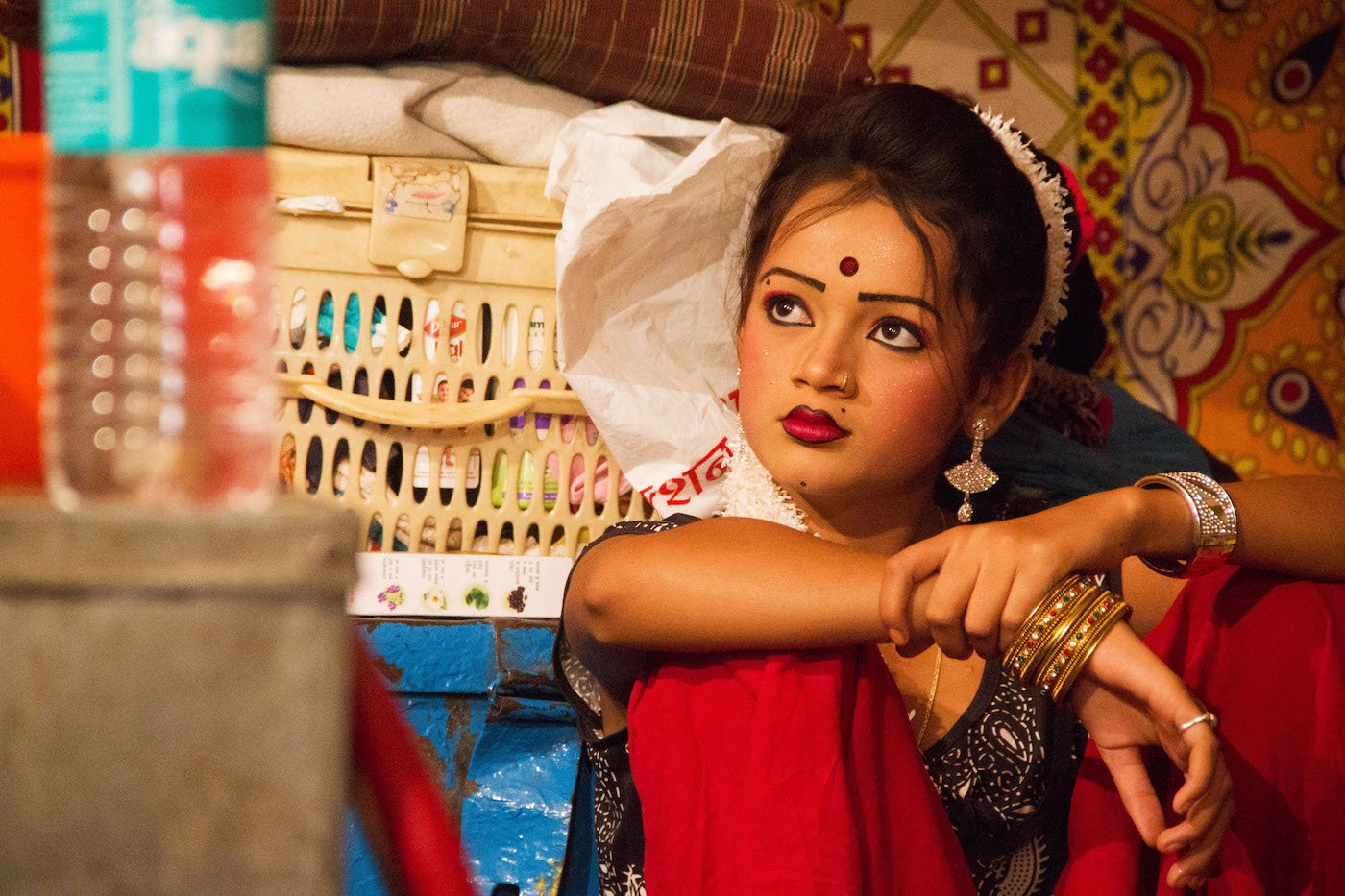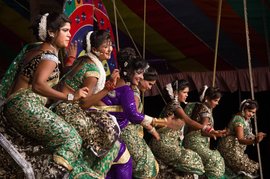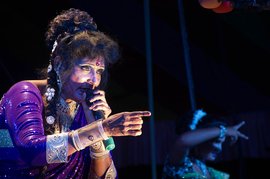“ Eh Komal! Kaay maal aahe !” “ Eh laal, chaan diste !” the men call out. Fifteen-year-old Komal, who’s dancing on stage, is used to catcalls inspired by the colour of her outfit or her name. “Some men in the audience compete for my attention. If I look at one guy, his friend will yell out ‘Don’t look at him, he has a girlfriend! Look at me’,” she says.
The female dancers in the Mangala Bansode and Nitin Kumar Tamasha Mandal also compete to see who gets the loudest appreciation. They urge the men to whistle and catcall louder, says Kajal Shinde, around 18 years old. “Have you not eaten… are you well?” they tease. “We cannot hear you!” they gesture, pointing to their ears.
Kajal is a lead dancer, as is Komal. Both work in the phad (troupe) headed by veteran tamasha artist Mangala Bansode, as do around 150 other artists and labourers. Tamasha is a still-popular folk art form in villages across Maharashtra. The phads travel to a different village almost every day during show season from September to May. Shows run from around 11 p.m. till even dawn sometimes, and are performed on an outdoor stage set up a couple of hours before the show and dismantled soon after. Mangalatai’s troupe is one of the most successful; many others are struggling with falling tickets sales and profits. (See ‘ Tamasha is like a jail that I want to stay in’ , and Tamasha: transformed but still travelling )


Audience appreciation determines a tamasha's success – to generate it, the female dancers must perform vigorously, listen to lewd comments, pretend to like the catcalls
At her phad ’s shows, the stage is dressed in colourful lights and flanked by huge speakers. A row of machines at the front spit fire during dramatic moments in the songs. The female dancers climb onto the metal poles fixed on the stage corners during some of the songs. “At times, the poles give us an electric shock. So we have to be careful,” says Komal, whose home is in Shevgaon village of Shevgaon taluka in Ahmednagar district.
The success of a tamasha troupe is determined by ticket sales – which in turn depend on the decibel levels of audience appreciation that a show can generate. “We ask them to whistle louder, because if the public enjoys, it gives our tamasha more dum [vigour],” says Kajal.
When the audience yells “once more” for popular songs, the troupe must comply. “We serve the public. We make them laugh and entertain them. We make them forget their problems,” says Mangalatai, now 66.
For this, it is mainly the female dancers who must perform vigorously, listen to frequently lewd comments, pretend to like the catcalls even if they don’t.


A tent backstage is usually the 'green room' to get ready. Right: At 66, troupe owner and veteran artist Magalatai Bansode still performs and draws crowds
The suggestive interaction with the audience can bring trouble. When the men make unwelcome advances before or after the show, Komal tells them she’s married. “Sometimes I lie and say I have five children,” she laughs. Komal’s father works as a manager with the phad and her mother was an artist with the troupe till she retired last year. Komal has enacted Lord Krishna on stage since she was seven, and left school at the age of 12 to work full-time. Her sister Rama, 28, is also a dancer in the same troupe.
Komal, Rama and the other dancers know that when the same man from the audience keeps track of the tamasha’s schedule and comes to several shows, it is a sign of trouble. At times, men approach the girls and ask for selfies. Usually, this involves warding off physical advances. “We try to avoid such situations and don’t give in to requests for selfies,” says Komal. “We have to ask the manager to intervene if a man follows us around.”
Not an ‘indecent’ profession
But the women also speak of the financial independence and recognition as artists that the tamasha has given them. “I loved dancing,” Kajal says, “and was once given the first prize for dance in my school.” In the tamasha industry, Kajal says she has enjoyed her time here – and the space it offers artists to perform.
Of the troupe of 150, around 25 are women or girls. The
tamasha
starts with a prayer performed by the men, and then moves on to a
gavlan
, a dance depicting the interaction between Krishna and the Gopis. The women dressed in pre-stitched nine-yard sarees for the
gavlan
must run back into the tent (their ‘green rooms’) and get ready for their next act. Each artist performs 7-8 songs, either as back-up or as lead dancers. The songs are usually Bollywood numbers, with a few Marathi movie songs and a popular Haryanvi/Bhojpuri track thrown in.

In Nayarangaon village: tents and a stage put up a few hours before the show become work spaces, but offer the women little privacy
Many in the villages consider the
tamasha
lifestyle ‘indecent’ and look down on the women who work in the
phads
. “When the audience uses abusive words like ‘
randi
’ and ‘
chinaal
’ [derogatory words for sex workers] to address us on stage, we have to calm them down without getting angry,” says Sharda Khade, 43, a dancer and actor in the troupe from Dhulgaon village in Tasgaon
taluka
of Sangli district. “We ask them, ‘Don’t you have mothers and sisters of your own, how can you speak to us like this?’ They say, ‘Our women are not like you. Why can’t you take up a stable job instead of working in the
tamasha
?’ We then tell them that this too is a job.”
The rigorous schedules and mandatory eight-month commitment are also hard on women employees, especially those who have small children. “We must offer high salaries to the women who join despite these constraints,” says Anil Bansode, Mangalatai’s son and manager of her troupe. The women artists in Mangalatai’s troupe were paid salaries starting at Rs. 10,000 per month for the 2017-18 tamasha year. Depending on the number of performances, experience and skills, the highest salary for non-lead artists is Rs. 16,000 this year.


Jyotsna (left) and Kajal Shinde (right, in blue) at a stop in Karavadi village of Satara district: the sisters support their family of eight with their earnings
Often, this is the only steady income that a family can depend on. Kajal Shinde, one of the lead dancers, and her sister Jyotsna, 28, support their family of eight in (Battis) Shirala village in Shirala
taluka
of Sangli district with their
tamasha
earnings. Kajal joined a
tamasha
some six years ago, when she was around 12, and Jyotsna after her husband left her a few years ago. Her income helps provide for her 10-year-old son and 7-year-old daughter, who live in the village with her mother.
“My daughter was just a baby, I was still nursing her when I had to leave her with my mother and join the troupe,” says Jyotsna. Kajal has decided not to get married till everyone in her family is settled. When she first spoke to her mother of joining a phad , her mother was against the idea. But Kajal managed to convince her that dancing in the tamasha was not an indecent occupation.
Seeing privacy, ignoring pain
The tamasha artists travel for around 210 days a year between September and May. During this time they live out of suitcases and sleep on the bus rides from one village to another. Even the women are forced to bathe in the open if they cannot find public bathrooms. Sharda says that the troupe is like a family, and “men leave the women’s tent when we’re changing. Or they look away if we have to change in the open. But some do keep looking…”
“When we change in the tents, villagers try to peep in at times,” Komal says. “We have to chase them away with curses. If they don’t listen, I take out my chappal and hurl it at them.” If matters get out of hand, the women ask their male colleagues or the manager or the cops usually present during the shows to intervene.
When the women are menstruating and on the move, Sharda says, “we try to find a public toilet and change.” Komal adds that she longs to be at home every time she has her period. She misses the privacy, but pushes through the discomfort. Rama, her older sister, says that they have to just work through menstrual cramps if they have an important role in the
tamasha
. “If we are in many songs or have a lead role, we cannot rest even during period pain; however ill we may be, we must go on stage,” she says.


The troupe travels for 210 days a year between September and May. During this time they live out of suitcases and sleep on the bus rides from one village to another
Rama, also a lead dancer, has a two-year-old
daughter, Bhakti. “I worked till the end of the season when I was pregnant with
her. She was born in the annual break between seasons. Just a month and a half later,
I was back on the road for work,” she says. Till last year, Rama’s mother Vimal, then a singer in the same troupe, would help look after the baby. “It’s been more difficult to take care of Bhakti this year because my mother is at home now. If Bhakti cries just as I’m about to go on stage, it gets really difficult to leave her and go. She does not stop crying until she sees me,” Rama says.
If the father of the child works in the same troupe, it gets a little easier to take care of the kids because while one parent is on stage, the other can take care of the child.
Delivering songs and babies – on stage
But it’s the story of veteran artist Vithabai Naranyangaonkar’s on-stage delivery that is the stuff of tamasha legends. She felt herself going into labour and asked her daughter to increase the number of songs between her scenes. Then, the story goes: backstage, in a tent, without any help, she delivered her own baby (Mangalatai’s brother Kailas Sawant), wrapped him in a blanket and went back on stage to perform the rest of the tamasha .
Mangalatai, Vithabai’s eldest daughter, had a similar experience during the birth of her youngest son Nitin in 1976. “We were performing a historical vag natya [folk drama],” she says. “We were in the midst of a fight scene when my husband gestured to convey to me what was happening.” Mangalatai was in labour.


Menstruation, childcare, illnesses – are all handled on the go. Left: Lead dancer Rama Dalvi's mother Vimal (a singer in the phad till last year) has helped look after Rama's baby. Right: Makeshift cradles are made from sarees for babies to sleep in backstage during tour stops
“I didn’t notice what was happening to me because I was completely engrossed in the scene,” she says. “When I realised this, I started feeling dizzy. I went backstage and some women in the village helped me deliver. After I delivered, I wore my costume and went back on stage – but the public had left out of respect.”
Bharti Sonawane, 53, Mangalatai’s younger sister and a singer in the troupe, adds, “After I delivered each of my three children, I was back on stage within two weeks. Just like my mother, I took no break when my children were born.”
Daily travelling, and erratic schedules and mealtimes, can take a toll on the troupe members’ overall health. “If someone is ill, you can go to the hospital only during the day. At night, we have to be on stage,” says Rama. Last year, when little Bhakti was ill, the tamasha troupe was performing in the same village for two days. “She was in hospital and had to be put on saline. I spent the day with her and would still perform on stage at night,” Rama says.
Rama has decided to leave Bhakti at home when she is older. “I don’t want her to work in the tamasha because the public has become increasingly unruly over the years. Who knows how bad it will get in a few years?”


